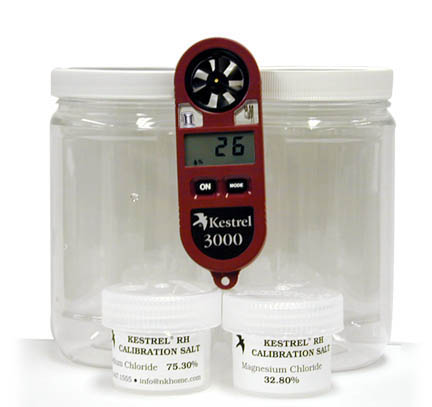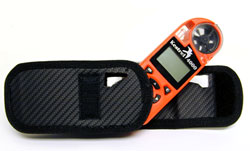|
Please read ALL the instructions
before attempting to calibrate your Kestrel.
Click for instructions:
Here for Kestrel
3000 models manufactured before August 2004
Here for Kestrel
3000 models manufactured after August 2004
Here for Kestrel
3500 models
Here for all
versions of the Kestrel 4000
About Factory Calibration:
Each Kestrel Pocket weather Meter is individually calibrated after
assembly. In essence, each unit is "taught" what the correct
relative humidity (RH) values should be for given signals from the RH
sensor.
NK calibrates at RH=32.8% and RH=75.3%.
Calibration is done in two sealed environmental chambers maintained at
25°C. The humidity is held constant with saturated aqueous salt baths:
magnesium chloride for the RH 32.8% chamber and sodium chloride for the
75.3% chamber.
Chamber temperatures are held constant at 25°C ± 0.5°C
The temperature and RH of each chamber is independently monitored using
a precision chilled mirror dew point hygrometer (EdgeTech Model 2002)
accurate to ± 0.1Cº and NIST (National Institute of Standards and
Technology) traceable.
A proprietary auto calibration routine controls the calibration
process.
After 60 minutes this routine stores a calibration value which forces
the Kestrel to be correct at the RH value of the chamber.
The response of
the humidity sensor is a highly reproducible, non-linear curve.
This non-linear characteristic is stored in the microprocessor used to
compute RH, and in this manner we are able to maintain an accuracy of ±
3% of scale over the relative range 5% - 95%.
Field Calibration:
The Kestrel should be recalibrated if the RH sensor has been replaced or
has shown drift in its RH measurement.
This manual explains the steps for calibrating the humidity measurement
for the Kestrel. This process will take approximately 3 hours,
including setup and calibration.

Setting up the Humidity Chambers:
- Open
the sodium chloride container and move all of the contents into one
of the large containers. Use a scraper to make sure to collect ALL
of the salt solution.
-
Tightly screw the lid on the large container.
- Open
the magnesium chloride container and move all of the contents into
the other large container. Use the OTHER scraper to make sure to
collect ALL of the salt solution.
-
Tightly screw the lid on the large container.
- Let
these containers sit closed, containing the salt solutions,
for at least 1 hour. Any less than 1 hour is insufficient
for the chamber to settle and will yield poor calibration. If
possible, let the container sit for 12 hours.
- You
may want to remove the lanyard from the Kestrel in order to avoid
getting salt solution on the Lanyard. The Kestrel can be rinsed
after calibration to remove any salt solution.
RH Verification:
It is
possible to test the Kestrel at humidity values other than 32.8% and
75.3%. To set up a test at another RH value, simply use a different
saturated salt solution in the humidity chamber. Refer to the table on
page 10 for various salts and their corresponding RH values.
To test
the accuracy of the Kestrel at various RH values:
- Set
up a large container with a saturated salt solution using any one of
the salts from the table shown below.
-
Place the open small container inside one of the sealed large
containers and let sit for at least 12 hours.
- Turn
on the Kestrel and put it into relative humidity mode.
-
Place the Kestrel inside the sealed large container and let it sit
for at least 30 minutes. After 30 minutes, the Kestrel should
display an RH value within ± 3% of the chart listing.
|
SALT
BATH |
PUBLISHED RH AT 25°C |
|
LITHIUM
BROMIDE |
6.37% |
|
LITHIUM
CHLORIDE |
11.30% |
|
POTASSIUM
ACETATE |
22.51% |
|
MAGNESIUM
CHLORIDE |
32.80% |
|
POTASSIUM
CARBONATE |
43.16% |
|
MAGNESIUM
NITRATE |
52.89% |
|
SODIUM
BROMIDE |
57.57% |
|
POTASSIUM
IODIDE |
68.86% |
|
SODIUM
CHLORIDE |
75.30% |
|
POTASSIUM
CHLORIDE |
84.34% |
|
POTASSIUM
SULFATE |
97.30% |
*Based on:
Humidity Fixed Points of Binary Saturated Aqueous Solutions,
Greenspan, Lewis; Journal of Research of the National Bureau of Standards-A.
Physics and Chemistry, Vol. 81A, No. 1, January-February 1977
|











